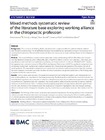| dc.contributor.author | Ivanova, Dima | |
| dc.contributor.author | Bishop, Felicity L | |
| dc.contributor.author | Newell, Dave | |
| dc.contributor.author | Field, Jonathan | |
| dc.contributor.author | Walsh, Madeleine | |
| dc.date.accessioned | 2023-03-08T15:27:48Z | |
| dc.date.available | 2023-03-08T15:27:48Z | |
| dc.date.issued | 2022-09-02 | |
| dc.identifier.citation | Ivanova, D., Bishop, F. L., Newell, D., Field, J., & Walsh, M. (2022). Mixed methods systematic review of the literature base exploring working alliance in the chiropractic profession. Chiropractic & manual therapies, 30(35). https://doi.org/10.1186/s12998-022-00442-4 | en |
| dc.identifier.issn | 2045-709X | |
| dc.identifier.uri | https://aecc.archive.knowledgearc.net/handle/123456789/180 | |
| dc.description | Available under Creative Commons attribution: https://creativecommons.org/licenses/by/4.0/ | en |
| dc.description.abstract | Background
The construct of working alliance has been used to operationalise the patient–clinician relationship. Research evidence from the rehabilitation literature has established an association between the construct and several patient outcomes. The aim of this systematic literature review was to study working alliance in the chiropractic discipline.
Method
This review followed a mixed method systematic review methodology: EBSCO (The Allied and Complementary Medicine Database), EBSCO (MEDLINE), EBSCO PsycINFO, Web of Science Core Collection, Chiro index, and grey literature were searched for quantitative, qualitative, and mixed methods studies on 17th March 2021. Qualitative appraisal was conducted using the Mixed Methods Appraisal Tool, version 2018. The qualitative component was synthesised via thematic synthesis and explored patients’ and chiropractors’ perceptions of the nature and role of working alliance. The quantitative component was synthesised via narrative synthesis to examine how the construct has been measured in research and what its effect on clinical outcomes and patient satisfaction is. The findings were integrated in the discussion section.
Results
Thirty studies were included. The qualitative component found that both patients and chiropractors consider working alliance as a key factor in the treatment journey. The findings illustrated that the construct includes the bond between a patient and a chiropractor which is underpinned by trust and attentiveness to patients’ needs, values and preferences. Qualitative data also suggested that strong working alliance has the potential to improve patients’ adherence to treatment and that it is characterised by ongoing negotiation of expectations about the goals of care and the tasks involved in the treatment plan. The quantitative component highlighted that even though working alliance is relevant to the chiropractic discipline, very few studies have quantitatively measured the construct and its effect.
Conclusion
The findings of this review emphasise the subjective importance of working alliance in the chiropractic clinical encounter. However, there were not enough homogenous studies measuring the effect of working alliance on clinical outcomes and patient satisfaction to conduct a meta-analysis. Future research should focus on evaluating potential direct and mediated effects on patient outcomes. | en |
| dc.language.iso | en | en |
| dc.publisher | Chiropractic & Manual Therapies | en |
| dc.subject | Working alliance | en |
| dc.subject | Chiropractor-patient relationship | en |
| dc.subject | Trust | en |
| dc.subject | Collaboration | en |
| dc.subject | Shared decision-making | en |
| dc.subject | Systematic review | en |
| dc.subject | Communication | en |
| dc.subject | Narrative synthesis | en |
| dc.subject | Thematic synthesis | en |
| dc.subject | Contextual factors | en |
| dc.title | Mixed methods systematic review of the literature base exploring working alliance in the chiropractic profession | en |
| dc.type | Article | en |
| dc.identifier.doi | https://doi.org/10.1186/s12998-022-00442-4 | |
